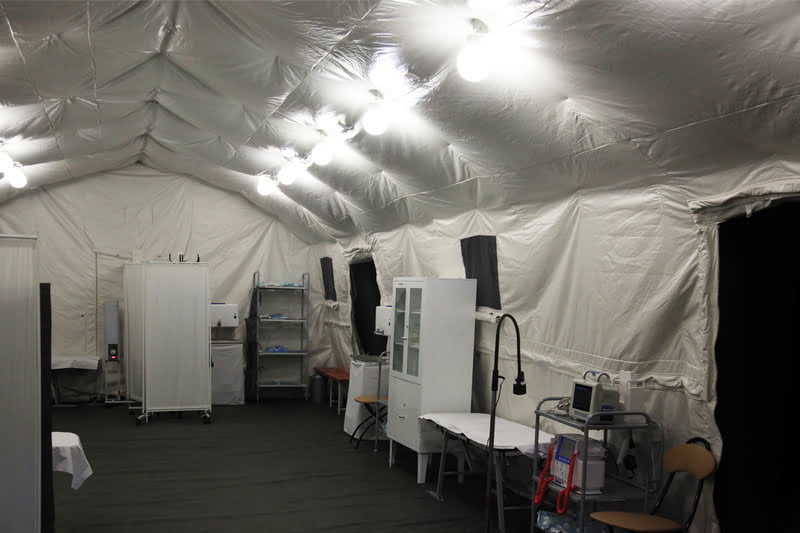Healthcare systems all over the world were challenged once COVID-19 hit the masses. Without any reservations, it affected most of the population, regardless of status or age. Naturally, those in the vulnerable sectors of society were hit the hardest. Unfortunately, considering how widespread the virus was (and continues to be), it infected hundreds of people each week—some areas even had thousands of cases every day.
Because of the sudden surge of patients, most hospitals suffered the impact. Staff shortages occurred due to staff exposure to severe cases, inability to provide proper treatment to some patients with supply depletion, incapability to attend to patients affected by other conditions, or the after-effects of COVID-19. Fortunately, communities have formulated a solution: field hospitals.
Since the primary issue for the healthcare system is its inability to keep up with its patient load, deployable field hospitals are meant to target sections of a local community to divide patient quantity better. This way, healthcare professionals can attend to patients, regardless of whether they’re COVID patients or not. Considering their importance, healthcare leaders regard their establishment highly. Therefore, they must be designed according to what’s expected from them. Here are some ways to design field hospitals the right way:
1. Maximize Experience
It takes careful attention to manage a field hospital successfully. However, with so many components involved in establishing one, taking all of them into account can easily overwhelm an inexperienced planner. For the project to achieve its goals, having an experienced team managing the build can speed things up.
Having experience reduces the time needed for preparation by a fraction. Instead of continuously inquiring about certain aspects, those with experience building a field hospital have the know-how to handle this. Moreover, given they’ve dealt with a similar project before, they can even recommend better solutions to improve the building phase’s efficiency.
2. Determine A Location
Aside from experience, planners must look into another priority: how much space their field hospital should have. As long as the virus is still present, an indefinite number of patients are bound to come into hospitals. Even if the number of cases decreases, it’s likely to hike up once more when COVID-19 safety protocols loosen.
Ideally, finding a clearing would be the perfect spot for setting up a field hospital. However, not all communities have thousands of square feet going unused. And considering how much pressure local hospitals have on their shoulders, it’s almost impossible to demolish old buildings for a field hospital. Thus, instead of clearing them up, healthcare leaders encourage community leaders to utilize empty buildings, namely storage buildings, stadiums, or sports stadiums.
3. Gather Necessary Equipment
Before any major technological breakthrough in the medical field, the tools healthcare professionals used previously only performed the bare minimum. However, being able to do basic functions was enough at the time, though not all guaranteed promising results.
Now, medical technology has reached new heights that enable practitioners to operate on their patients to the full extent. Moreover, considering how technology improves over time, convenience is one quality experts continue to maximize daily. Since field hospitals are meant to handle emergency cases or excess patients, planners must thoroughly check that all medical equipment and other resources are taken care of.
4. Develop A System
With COVID-19 cases fluctuating as it is and resource stretched thin across other field hospitals, restocking medical supplies (such as PPE and other essentials) might seem challenging with current supply shortages. Aside from that, some patients have conditions that are far more severe but are unable to receive immediate medical attention anywhere except a nearby field hospital. Furthermore, transferring them to a proper health establishment must be considered, especially if their condition is slowly deteriorating.
These are some complications practitioners will encounter, be it a proper medical establishment or field hospital. Although you can’t expect every one of your staff is an expert at handling medical disputes, preparing them is still better than remaining unaware. Naturally, experienced planners will have an edge since they’re familiar with what goes on in field hospitals. Nonetheless, laying out systems for each situation ahead of time must be done to manage all of them better.
5. Encourage Teamwork
Unless you have all the time in the world on your side, it’s impossible to execute a large project all on your own. After all, the reason field hospitals are deployed in the first place is due to patient overload overwhelming large medical facilities. Thus, it’s safe to say that there’s little to no time for an individual to implement a field hospital and expect promising results.
For the project to be successful, it demands numerous planners to enact their respective tasks. From ensuring the social distancing policy remains in place to setting up a system for feeding all patients on time, numerous elements must be monitored to guarantee the field hospital is well-designed and performs as expected. Naturally, they can only be carried out with clear communication among planners and unending cooperation.
Takeaway
Managing the pandemic’s effects on society has been a grueling task. Not only did it affect millions of lives, but it also challenged numerous systems, especially the healthcare system. Fortunately, experts have formulated multiple solutions in a short time, namely field hospitals. Since not everyone is a healthcare expert, planning a field hospital project might sound overwhelming, much less a well-designed one. But with the proper guidelines, it’s possible to create a working facility.
Photo 46429657 © Mastercard Popov | Dreamstime.com

